The greenhouse effect
Information sheet
CSIRO Atmospheric Research Information Sheet
Our atmosphere consists of a mixture of gases including
nitrogen, oxygen and water vapour. Also present are small quantities of
carbon dioxide, methane and a number of other “trace” gases.
Sunlight passes through the atmosphere, warming the earth’s surface.
In turn, the land and oceans release heat, or infrared radiation, into
the atmosphere, thus balancing the incoming energy. Water vapour, carbon
dioxide and some of the other trace gases absorb part of this radiation,
allowing it to warm the lower atmosphere, while the remainder is emitted
to space. This absorption of heat, which keeps the surface of our planet
warm enough to sustain us, is called the greenhouse effect. Without heat-trapping
greenhouse gases the surface would have an average temperature of –18°C
rather than our current average of 15°C.
Atmospheric trace gases that keep the earth warm are known as greenhouse
gases. About three-quarters of the natural greenhouse effect is due to
water vapour. The next most significant greenhouse gas is carbon dioxide.
Since the industrial revolution and expansion of agriculture around 200
years ago, we have been pumping additional carbon dioxide gas into the
atmosphere. Today, the concentration of this gas is approximately 30 per
cent greater than in the 18th century. Levels of other greenhouse gases
have also increased because of human activities.
Higher concentrations of greenhouse gases in the earth's atmosphere will
lead to increased trapping of infrared radiation. As a result, the lower
atmosphere is likely to warm, changing weather and climate.
The changes will add to the natural greenhouse effect, producing an enhanced
greenhouse effect. (The enhanced greenhouse effect is often referred to
as climate change or global warming.)
Australian scientists are making significant contributions to assessments
by the Intergovernmental Panel on Climate Change (IPCC), which was established
in 1988 by the World Meteorological Organization and the United Nations
Environment Program. The IPCC issued its first set of reports on the science
of climate change, likely impacts and response strategies in 1990.
In 2001, hundreds of specialists from around the world have again contributed
their knowledge to the IPCC’s Third Assessment Report. (View the
Working Group I Summary for Policymakers.)
Greenhouse gases
The main greenhouse gases that are increasing in concentration due to
human activities are carbon dioxide, methane, nitrous oxide, chlorofluorocarbons
(CFCs), and ozone in the lower atmosphere.
Greenhouse gases differ in their contributions to global warming. For
example, molecule for molecule, nitrous oxide and methane are more potent
greenhouse gases than carbon dioxide.
| |
Carbon dioxide |
Methane |
Nitrous oxide |
CFC-11 |
| Current concentration |
370 ppmv |
1720 ppbv |
312 ppbv |
260 pptv |
| Pre-industrial concentration (~1700s) |
288 ppmv |
850 ppbv |
285 ppbv |
0 |
| Annual rate of increase |
0.4% |
0.6% |
0.25% |
0* |
| Atmospheric lifetime |
50-200 years |
12 years |
120 years |
50 years |
*Atmospheric concentrations of many ozone-depleting
substances are now declining;
approximate values only presented in the table.
Carbon dioxide (CO2)
Most of the increase in carbon dioxide comes from burning of fossil fuels
such as oil, coal and natural gas, and from deforestation.
Currently, about 7 billion tonnes of carbon (as carbon dioxide) are emitted
each year during the combustion of fossil fuels and 1-2 billion tonnes
per year from land clearing.
In Australia, annual carbon dioxide production per person is about 16
tonnes.
| Carbon dioxide concentrations measured at the Cape
Grim Baseline Air Pollution Station in north-western Tasmania. |
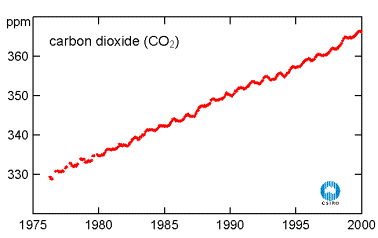 |
Scientists study the composition of air in the past by examining air
trapped in Antarctic ice.
Analysis of these bubbles shows that carbon dioxide concentrations are
now higher than at any time in the past 420,000 years. In fact, it is
likely that the concentration today is higher than it has been for 20
million years. The current rate of increase of carbon dioxide is greater
than at any time in the past 20,000 years.
Scientists can infer from the ice records past temperatures of the atmosphere.
There is a close relationship between atmospheric carbon dioxide concentrations
and world temperatures. Periods of high global surface temperature have
occurred when carbon dioxide concentrations have been high.
| Fluctuating carbon dioxide concentrations during
the past thousand years, from measurements of air trapped in Antarctic
ice (supplied by the Australian Antarctic Division) and, since the
late 1970s, from analysis by the Cape Grim Baseline Air Pollution
Station in Tasmania. |
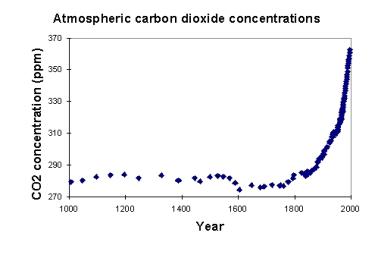 |
|
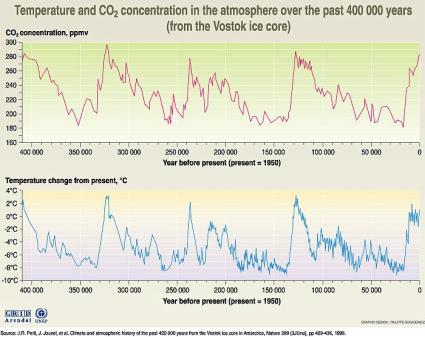
|
Variations in atmospheric carbon dioxide concentration
and temperature during the past 400,000 years.
(Reproduced from Nature) |
Methane (CH4)
Methane forms when organic (carbon containing) material is broken down
in the absence of oxygen. Ruminant animals such as cows and sheep rely
on bacteria to decompose the cellulose they eat. These bacteria generate
methane. Bacteria also play a role in releasing methane from rice paddies.
Other sources of methane are land fills, burning vegetation, coal mines
and natural gas fields.
The concentration of atmospheric methane continues to rise, with levels
today greater than at any time during the past 420,000 years. The growth
rate of methane slowed and was more variable in the 1990s than in the
1980s. Slightly more than half of methane emissions come from human sources,
such as those listed above.
Most atmospheric methane is eventually converted into carbon dioxide.
| Methane concentrations measured at the Cape Grim
Baseline Air Pollution Station. |
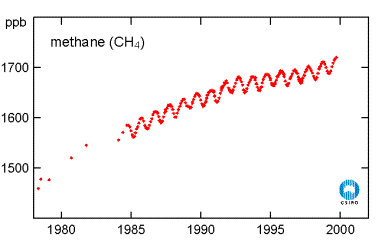 |
Nitrous oxide (N2O)
Nitrous oxide concentrations are increasing because of land-use changes,
biomass burning, fertiliser use and some industrial processes.
Nitrous oxide is an important greenhouse gas, as it does not easily break
down. It has an atmospheric lifetime of more than a century. Present concentrations
of the gas have not been exceeded for at least the past 1000 years.
Approximately one-third of nitrous oxide emissions are from human sources.
Oceans and soils are natural sources of nitrous oxide.
| Nitrous oxide concentrations measured at the Cape
Grim Baseline Air Pollution Station. |
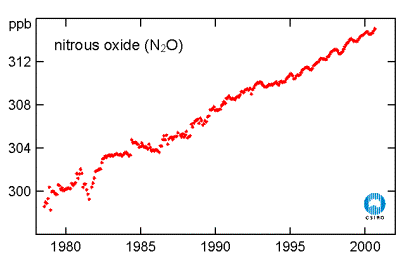 |
Chlorofluorocarbons (CFCs)
Chlorofluorocarbons are all industrially-produced chemicals. They do
not occur naturally. Chlorofluorocarbons were first used in the 1920s
as coolants for refrigerators. Since then they have been used in air-conditioners,
as propellants in aerosol cans (before 1990 in Australia), to make the
bubbles in plastic foams and as solvents. CFCs are very stable and last
for about 50 years in the atmosphere.
As well as being greenhouse gases in the lower atmosphere, once in the
stratosphere, CFCs damage the ozone layer.
Thanks to the Montreal Protocol, CFC production in developed countries
has ceased and atmospheric concentrations of many CFCs are now falling.
The warming effect of CFCs is offset by the fact that they destroy ozone,
also a greenhouse gas, in the lower stratosphere.
| CFC-11 concentrations measured at the Cape Grim
Baseline Air Pollution Station. |
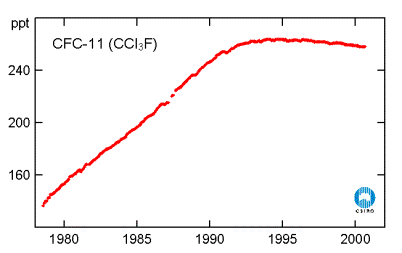 |
Ozone (O3)
Ozone is a component of photochemical smog, which is a problem in many
cities. In the lower atmosphere (the troposphere), ozone is a powerful
greenhouse gas.
There is strong evidence that ozone concentrations in the lower atmosphere
are higher than in pre-industrial times, especially in the northern hemisphere.
Atmospheric aerosol
Aerosol are fine particles and droplets suspended in air. Fossil fuel
and biomass burning add to levels of aerosol in the atmosphere.
Aerosol predominantly have a cooling effect on climate by reflecting
some of the incoming sunlight and through their influence on cloud properties
— they facilitate the process by which water vapour turns into cloud
droplets.
Likely changes to global climate
Scientists are using sophisticated computer models of the world's atmosphere,
land and oceans to examine likely future changes to climate due to the
enhanced greenhouse effect.
The models show that increasing levels of greenhouse gases will produce
a warming at the earth’s surface and that the enhanced greenhouse
effect is likely to lead to world-wide changes in weather and climate.
Some places may get more rain and storms while others may get less. Not
all changes will be bad for everybody. However, almost everywhere the
weather and climate will be different from what it used to be.
Climate models show that land will warm more than the sea. The daily
temperature range over land is likely to decrease. The greatest warming
is expected to occur in the sub-polar regions of the northern hemisphere
during winter.
Global warming is likely to lead to greater extremes of drying and heavy
rainfall. It is also likely to increase the risk of droughts and floods.
During the 20th century, the world’s average surface temperature
increased by about 0.6°C. According to the Intergovernmental Panel
on Climate Change (IPCC), most of the warming that has occurred during
the past 50 years is due to human activities.
By the end of the 21st century, average world temperatures are likely
to be between 1.4°C and 5.8°C higher than they were in 1990.
This projected rate of warming is much larger than the observed changes
during the 20th century and is very likely to be without precedent during
at least the past 10,000 years.
Sea level
Warming of the earth's atmosphere will lead to warming of the upper layers
of the oceans. Like most substances, water expands when heated. Expansion
will raise sea level. Land-based ice in the temperate regions of the world
(such as South and North America and Greenland) will melt more rapidly,
adding to increased sea level. (Floating sea ice does not change the sea
level when it melts.)
On the other hand, increased precipitation over Antarctica and Greenland
could lock water away in the ice caps, ultimately reducing the extent
of sea-level rise.
During the 20th century, global sea level rose by between 10 and 20 cm.
Sea level is projected to rise by between 9 and 88 cm between 1990 and
2100.
Climate change in Australia
In 2001, CSIRO Atmospheric Research released projections describing likely
changes to Australia’s climate.
Australia will be hotter and drier. Over most of the continent, annual
average temperatures will be 0.4 to 2°C greater than 1990 by 2030.
By 2070, average temperatures are likely to increase by 1 to 6°C.
Most parts of Australia will experience more frequent, or heavier, downpours.
In places where average rainfall increases, there will be more extremely
wet years. Conversely, there will be more droughts in regions where average
rainfall decreases.
The warming will not be uniform. There will be slightly less warming
in some coastal areas and Tasmania, and slightly more warming in the north-west.
Warmer conditions will produce more extremely hot days and fewer cold
days. For example, the average number of days over 35°C each summer
in Melbourne are likely to increase from 8 at present to 10-20 by 2070.
The average number of winter days below 0°C in Canberra is likely
to drop from 44 at present to 6-38 by 2070.
South-western Australia can expect decreases in rainfall, as can parts
of south-eastern Australia and Queensland. Decreases will be most pronounced
in winter and spring.
There are also likely to be more intense tropical cyclones, leading to
an increase in the number of severe oceanic storm surges in the north.
Evaporation will increase over most of the country, adding to moisture
stress on plants, and to drought.
Paul Holper
June 2001 |